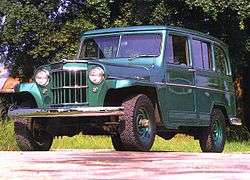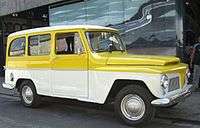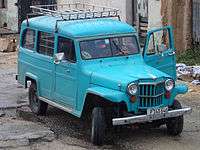Willys Jeep Station Wagon
| Willys Jeep Station Wagon | |
|---|---|
 | |
| Overview | |
| Manufacturer | |
| Also called | Ford Rural, IKA Estanciera |
| Production | 1946–1981 |
| Body and chassis | |
| Class | Full-size car Sport utility vehicle |
| Body style |
|
| Related | |
| Dimensions | |
| Wheelbase | 104 in (2,642 mm)[1] |
| Length | 176 1⁄4 in (4,477 mm)[1] |
| Width | 72 in (1,829 mm)[1] |
| Height | 74 in (1,880 mm) |
| Curb weight |
|
| Chronology | |
| Successor | Jeep Wagoneer |
The Willys Jeep Station Wagon is an automobile which was produced by Willys in the United States from 1946 to 1965 with production in Argentina continuing until 1981 as the IKA Estanciera. It was the first mass-market all-steel station wagon designed and built as a passenger vehicle.[2]
With over 300,000 wagons and its variants built in the U.S., it was one of Willys' most successful post-World War II models. Its production coincided with consumers moving to the suburbs.
The Jeep Wagon was assembled in several international markets under various forms of joint ventures, licenses, or knock-down kits.
Development and reception
The Jeep Wagon was designed in the mid-1940s by industrial designer Brooks Stevens.[3] Willys did not make their own bodies, car bodies were in high demand, and Willys was known to have limited finances. Brooks therefore designed bodies that could be built by sheet metal fabricators who normally made parts for household appliances and could draw sheet metal no more than 6 inches (152 mm).[4]
The Jeep Wagon was the first Willys product with independent front suspension. Barney Roos, Willys' chief engineer, developed a system based on a transverse seven-leaf spring. The system, called "Planadyne" by Willys, was similar in concept to the "planar" suspension Roos had developed for Studebaker in the mid-1930s.[5]
The steel body was efficient to mass-produce, easier to maintain and safer than the real wood-bodied station wagon versions at the time.[6] Within the first two years of the Jeep Wagon's production, the only manufacturer in the United States with a station wagon that was comparable in price was Crosley,[5] who introduced an all-steel wagon in 1947.[7] With a wheelbase of 80 inches (2,032 mm) and an overall length of 145 inches (3,683 mm),[7] Crosley's wagon was much smaller than the Jeep Wagon, and was described as "diminutive"[7] and "tiny".[5]
Production timeline


USA
- 1946: introduced as the 463, powered by the L-134 Go-Devil flathead inline-four engine.
- 1947: a panel van introduced with one seat, a pair of doors instead of the wagon's tailgate, and no side windows behind the front doors.[8]
- 1948: introduction of the 663, powered by the L-148 Lightning straight-six engine.. A luxury version, the Station Sedan, had solid body colors with basket-weave trim on the sides and was better finished than the wagon throughout.[5]
- 1949: four-wheel drive became an option.[8]
- 1950: the flat grille was replaced by a pointed v-shape design with five horizontal bars across the vertical ones. The 473 model got the new 'F-134 Hurricane, and the 673 model got a new 161 cu in (2.6 L) version of the Lightning six. Station sedan discontinued.[8]
- 1952: the flathead Lightning was dropped in favor of the F-161 Hurricane, installed in the 685 model.
- 1954: the first under Kaiser's ownership. The 6-226 Super Hurricane, a flathead inline six, was introduced. This was a version of the Kaiser Supersonic/Continental Red Seal engine and became available on four-wheel drive versions in 1954. Minor revisions were made to front end styling that year, including the reduction of the number of horizontal slats in the grille from five to three. There were few other changes between 1953 and 1955.[9]
- 1955: a number of new models were added. The 6-226 model lineup gained stripped chassis, flat face cowl, cowl/windshield, and ambulance models. The 475 line received only the cowl/windshield. Willys withdrew from the passenger car market and renamed the vehicle the Utility Wagon. The seventh seat and the overdrive were deleted, and the Planardyne front suspension used with the two-wheel drive wagon was replaced with a beam axle. Warn hubs, with which the front drive mechanism could be disengaged by turning the hubs by hand, became optional on four-wheel drive models.[10]
- 1958: the Maverick model introduced, a more luxurious version of the two-wheel drive wagon. It could be had only with the four-cylinder engine. The main upgrades were in the introduction of two-tone paint with matching interior in two tones and the standard AM radio. It was distinguished by its extra stainless steel trim ring under the windows. The Maverick name came from the TV series of the same name, of which Willys was a sponsor.
- 1962: the 6-230 Tornado OHC engine was introduced midyear, replacing the flathead.
- 1965: production ends as the Willys model had been phased out by the Jeep Wagoneer.
Brazil
In the 1950s a version based on the 1946 US version was introduced. A truck version, the Pick Up, was introduced in 1961. Ford Brazil bought the Willys factory in 1967 and the wagon was renamed Ford Rural, and the truck the Ford F-75. Both models were offered with an inline-six engine which was the first gasoline engine manufactured in Brazil. They were available in RWD or 4X4 configuration. The Rural was discontinued in 1977 and the F-75 in 1981.[11]
Argentina
The Jeep Wagon was produced as the IKA Estanciera by Industrias Kaiser Argentina from 1957 to 1970.
Notes
- 1 2 3 1953 Willys Jeep Brochure
- ↑ Olsen & Lyons 2000, p. 27.
- ↑ Olsen & Lyons 2000, p. 28.
- ↑ Brown 1994, pp. 66,68.
- 1 2 3 4 Brown 1994, p. 70.
- ↑ Olsen & Lyons 2000, p. 29.
- 1 2 3 Olsen & Lyons 2000, p. 33.
- 1 2 3 Brown 1994, p. 72.
- ↑ Brown 1994, p. 86.
- ↑ Brown 1994, p. 90.
- ↑ TATAREVIC, BOZI. "The Tale Of The Ford Rural And F-75 Truck". Retrieved 24 May 2015.
References
- Bradsher, Keith (2002). High and Mighty: SUVs: The World's Most Dangerous Vehicles and How They Got that Way. PublicAffairs. p. 5. ISBN 978-1-58648-123-0.
- Brown, Arch (1994). "Chapter Four – Postwar Plans for Willys: 1945-52". Jeep: The Unstoppable Legend. Lincolnwoood, IL USA: Publications International. ISBN 0-7853-0870-9. LCCN 94-66811.
- Foster, Patrick R. (2003). Standard Catalog of Jeep 1940-2003. Krause Publications. ISBN 978-0-87349-522-6.
- Olsen, Byron; Lyons, Dan (2000). Station Wagons. MBI Publishing. p. 27. ISBN 978-0-7603-0632-1. Retrieved 4 August 2010.
- Redmond, Derek (24 June 2002). "Willys Jeep Station Wagons". The CJ-3B Page. Retrieved 2007-03-22.
- Vincent, Van (12 February 2010). "Chevrolet Suburban at 75 years old-Looking back". CarguideBlog. Retrieved 4 August 2010.
- 1953 Willys Jeep Brochure, 1953, Form No. 2CM-SWC2-2-551-GG, retrieved 2011-11-20 – via Oldcarbrochures.com
External links
| Wikimedia Commons has media related to Willys Jeep Station Wagon. |
| Jeep road vehicle timeline, 1945–1970s — next » | |||||||||||||||||||||||||||||||||||
|---|---|---|---|---|---|---|---|---|---|---|---|---|---|---|---|---|---|---|---|---|---|---|---|---|---|---|---|---|---|---|---|---|---|---|---|
| Type | 1940s | 1950s | 1960s | 1970s | |||||||||||||||||||||||||||||||
| 5 | 6 | 7 | 8 | 9 | 0 | 1 | 2 | 3 | 4 | 5 | 6 | 7 | 8 | 9 | 0 | 1 | 2 | 3 | 4 | 5 | 6 | 7 | 8 | 9 | 0 | 1 | 2 | 3 | 4 | 5 | 6 | 7 | 8 | 9 | |
| Traditional | CJ-2A | CJ-3A | CJ-5 | ||||||||||||||||||||||||||||||||
| CJ-3B | CJ-7 | ||||||||||||||||||||||||||||||||||
| CJ-6 | |||||||||||||||||||||||||||||||||||
| Dispatcher | DJ-3A | DJ-5/6 | AM General | ||||||||||||||||||||||||||||||||
| Compact SUV | Jeepster (VJ) | Jeepster Commando | Commando | ||||||||||||||||||||||||||||||||
| SUV | Willys Jeep Station Wagon | Cherokee (SJ) | |||||||||||||||||||||||||||||||||
| Wagoneer (SJ) | |||||||||||||||||||||||||||||||||||
| Compact pickup | Jeepster Commando | Commando | |||||||||||||||||||||||||||||||||
| Full-size pickup | Willys Jeep Truck | ||||||||||||||||||||||||||||||||||
| Gladiator | J-Series | ||||||||||||||||||||||||||||||||||
| Truck | Forward Control | ||||||||||||||||||||||||||||||||||
| Van | FJ-3/3A | FJ-6/6A | |||||||||||||||||||||||||||||||||